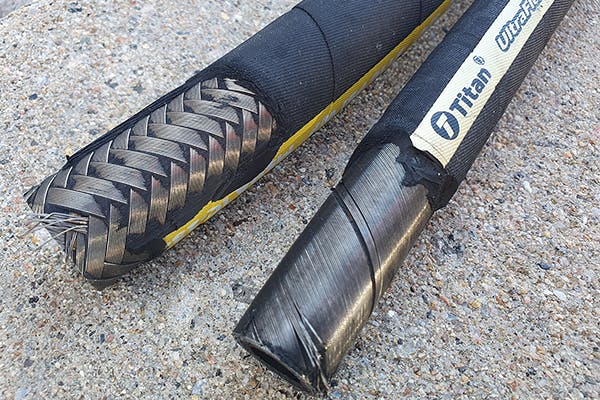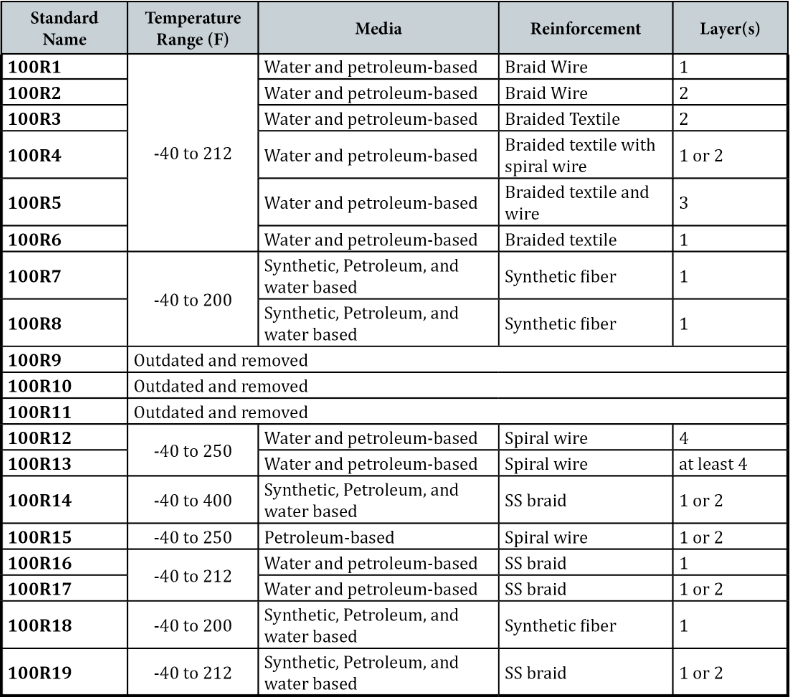Spiral vs Braided Hydraulic Hoses

Image Description: Titan Fittings braided hose on top, and Titan UltraFlex spiral hose on the bottom of the photo
Choosing the correct hydraulic hose is crucial to all hydraulic systems. It greatly depends on the application; however, novice engineers and technicians still struggle with selecting the correct hoses, particularly when choosing between spiral and braided hydraulic hoses.
Their end goal is the same; to carry hydraulic fluid between different hydraulic components like cylinders, reservoirs, valve bodies, and filters. However, modern hydraulic systems are more intricate and require a sound knowledge of hydrostatics to determine which hose type is the most suitable for an application.
Construction
All hydraulic hoses have the same three layers: an inner tube made of different material that determines which fluid type can be carried, a reinforcement layer(s), and an outer layer. The main difference between spiral and braided hydraulic hoses is in the construction method employed for their reinforcement layer.
For braided hoses, as their name implies, this layer consists of an alternating criss-cross pattern of steel wires that form a braid. The manufacturing process is quite complex, requiring giant braiding machinery that forms the braid over an extruded inner tube. Additionally, it requires an extensive quality check protocol to make sure the braids do not splinter; otherwise, the thickness of the end product gets affected.
On the other hand, spiral hoses also have steel wires wrapped around an inner tube, but instead of interlocking with each other, they run parallel to each other in a helical pattern. Manufacturing spiral hydraulic hoses is typically a faster process than braided hoses for the same number of reinforcement layers.
The construction method used gives each hydraulic hose different physical properties.
Flexibility
Braided hoses are more flexible than spiral hoses. That's because the interlocking pattern of the braids gives them a higher tensile strength. Spiral hydraulic hoses require additional layers of opposing spiral wires on top of each other to withstand the same pressure as braided hydraulic hoses, increasing their outer diameter and reducing their minimum bend radius. Hence, braided hydraulic hoses are ideal for applications where hoses need to be contorted in unorthodox positions to fit.
Durability
Durability is an aspect where spiral hoses outshine their braided counterparts. In hydraulic systems where changes in pressure are a common occurrence, hoses tend to expand and contract to compensate for the spikes and dips in pressure. Over time, these changes cause braided hoses to lose their tensile strength as the tightness between them weakens. Additionally, friction between braid wires causes expends heat which degrades the inner and outer tubes. Spiral braids tend to exhibit increased resistance to pressure changes making them more durable in the long run.
Uses
Most braided hoses are rated for low to medium pressure applications such as return lines, hydraulic lifts, and large engines. Spiral hoses are ideal for hydrostatic drives that operate at higher pressures with rapid pressure jerks. They are most commonly used in large specialized heavy-duty machinery like mining excavators and off-road dump trucks.
In North America, you'll find that the SAE standards are the most commonly used ones that specify minimum construction requirements for the hoses. Below is a table compiling hydraulic hoses that conform to this standard and what kind of construction they offer.

Final Word
Other factors must also be considered when selecting a hydraulic
hose for your application. Make sure it is fluid compatible, rated for the correct operating temperature, and has all the necessary fittings and accessories. This will ensure that your hydraulic system runs smoothly and prevents any unforeseen accidents from occurring.